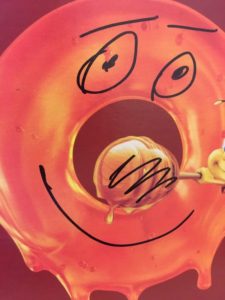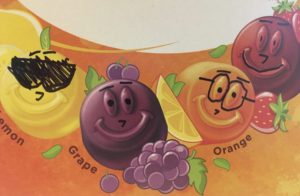I can’t take credit for the cool faces on all of these boxes. I have an artist in my home who learned this technique from a buddy. Since my son took it up, our home has exploded with fun faces that bust up the doldrums of household routines.

Just for giggles, here’s my how-to tutorial for Cereal Box Sharpie Art:
1.) Choose a cereal (or other) box.
2.) Grab a sharpie.
3.) Get creative.

How long has it been since you’ve given yourself complete creative freedom? When was the last time you recklessly abandoned the rules and thought, “What else could this be?” The ingenuity of this art form is its out-of-the-box thinking. Sorry guys, it just had to be punned.
Just in case you think I’m off my rocker, I’ll let you in on a little secret: I’m not a super-great artist. I love art, and I marvel at the classic, great artists who’ve earned every bit of their fame. But I am not, and will never be, one of those men or women.
I’m more of an “art-inspires-me-so-I-create” kind of artist. A lot of my work is just odd. I like it that way. But why in the world do I put it online for you to see and try for yourself?
Here’s the thing: I don’t care what category your profession falls under – healthcare, hospitality, computer software development, or waste management – every job needs innovative thinking. Are faces on cereal boxes innovative? Maybe, but they definitely shake things up, and they’re reminders.
Reminders that things can change.
So, if you’re stuck in any way, shape, or form in life, grab a sharpie and a box. Change it up! Remind yourself that even good things can be a little brighter when you add your creative thinking to them.
Until next time,
Invent your story

This seems like the easy part of creating an invention center – you just get the supplies you need. The thing is, without a method to the madness, it’s just madness. So here are three plumb line questions to keep you stockpiling instead of just making piles.
Does the material fit into the goal of your invention center?
I know I haven’t brought up the term “goal” in the context of your invention center before, but if you’ve come this far, you probably have a good idea of what yours is already. (If you haven’t read the first two posts on creating an invention center, you can read what it is and Part 1 to get caught up.) If you’re woodworking, you’ll need wood, screws, a drill, etc.
This is the no-brainer stuff to have around. Without a stocked area, you’ll get bogged down looking for that lost paintbrush or copper wire. This is why we’re making an invention center.
How much do you need to get started?
Sometimes the zeal to create can take over, and you end up with a lot more than you need – especially if it’s freebie stock. Like toilet paper rolls. There are tons of art and engineering projects you can do with toilet paper rolls. But if you keep saving and don’t use them, well it can just start to get weird.
There has to be a FULL point. Then move on.
Did you throw a wrench in your plan?
If the answer to the last question is “nope” – then it’s time to find that wrench and throw it into the stockpile! Hear me out on this one. If you want to create a maker’s space, that’s great, but this is a defining moment for your invention center. You want to have something in your invention center that challenges you to break the mold. More than something. A fair lot of things. An acorn from last fall’s hike. A bunch of rusty nails. One red sock.
These are the grains of sand that help your creative oyster make a pearl.
Until next time,
Invent your story
In my previous post, I promised to keep you updated on my invention center. Here’s my update: progress was slow. Why? I thought a lot about how to move forward with the space I have. Maybe I’ve been overthinking it. So, without further ado, here’s…
Tip #1.
Don’t Overthink It
Underthinking things in life (Can I afford this? Should I jump?) can get you into trouble. But overthinking is its own beast. Analysis paralysis is a real thing, so if you keep coming back to a space you have to work with and thinking, “That’s probably the best place to start…” it probably is.
That said, here are four more things to consider before making that final decision:
Tip #2.
Consider the Nature of the Work
If it’s electronics, you’re going to want a table and a nearby outlet. If it’s painting, an easel may be your best option. You also will want to consider the kind of floor you’re on. I want to do a little bit of everything and not destroy anything, so I went for a corner of our basement where the floor is painted concrete and an outlet is nearby.
Tip #3.
Remember Ventilation and Safety
Everything we do involves a level of risk, so it’s smart to assess yours and take precautions. If you’re going to be working with chemicals (paint thinners, glues, stains, etc.) that give off fumes, be sure your workspace has a window you can open when needed. Having a nearby water supply is helpful. Take the time to map out an emergency plan, so you are well prepared.
Tip #4.
Lighting Effects Work
When I was a kid doing homework at the kitchen table, my mom would walk by and flip on the overhead light for me. “It’s better for your eyes,” she’d say. Mom was right. Does your space have natural or overhead lighting? Would a small lamp be beneficial for you, and if so, where will that fit into things? It’s worth considering as you move forward with your new venture.
Tip #5.
Give Yourself Room to Grow
Starting small is starting smart, but don’t limit yourself or your imagination. Right now, my invention center is a table in the corner of the basement. Maybe one day it will be a super-techy-inspiring-for-inventors-everywhere place, but today, it’s a simple table with room to grow. And that, my friends, is not a bad beginning.
Until next time,
Invent your story

 This art is easy and super cheap to make. I love the how the 3D effect of weaving the cardboard pieces together really makes it pop. Although the design looked complicated, all you need are four cardboard U’s, glue, a utility knife, and paint.
This art is easy and super cheap to make. I love the how the 3D effect of weaving the cardboard pieces together really makes it pop. Although the design looked complicated, all you need are four cardboard U’s, glue, a utility knife, and paint.
 When creating a template for your cardboard U’s, keep in mind that the wider the U-shape is, the easier it will be to weave. Using a popcorn bowl for a guide works well.
When creating a template for your cardboard U’s, keep in mind that the wider the U-shape is, the easier it will be to weave. Using a popcorn bowl for a guide works well.
 Trace and cut out one piece using the circle guides (I used the popcorn bowl for the outer circle and pan lid for the inner circle) and then make 3 more “U” shapes from the first piece. Once they are all cut out, it’s time to weave them together. This can be a little bit tricky, but you can do it.
Trace and cut out one piece using the circle guides (I used the popcorn bowl for the outer circle and pan lid for the inner circle) and then make 3 more “U” shapes from the first piece. Once they are all cut out, it’s time to weave them together. This can be a little bit tricky, but you can do it.
 If you look at the design, you will see how they are woven together. Start with opposite sides. One “U” will go over the top of the other “U” and under the bottom of the other “U”. Then the third “U” weaves over one side “U” and under the other side “U”. The fourth “U” weaves over-under-over-under the other three, to complete the design.
If you look at the design, you will see how they are woven together. Start with opposite sides. One “U” will go over the top of the other “U” and under the bottom of the other “U”. Then the third “U” weaves over one side “U” and under the other side “U”. The fourth “U” weaves over-under-over-under the other three, to complete the design.
 Once your pieces are woven together, you can pull the ends out to secure the design. You will want to glue the ends to connect them. Hot glue works very well for this kind of project, and again, you’ll want to start with opposite ends. Be sure one side is cool before gluing the opposite sides.
Once your pieces are woven together, you can pull the ends out to secure the design. You will want to glue the ends to connect them. Hot glue works very well for this kind of project, and again, you’ll want to start with opposite ends. Be sure one side is cool before gluing the opposite sides.
 Once your design is intact, you can paint it! You can use green spray paint to give it a nice, even coat for a base. For the finishing touch, add a little gold metallic paint around the edges to accentuate the overall look. Whalah! Ready to dance a little jig? Me too!
Once your design is intact, you can paint it! You can use green spray paint to give it a nice, even coat for a base. For the finishing touch, add a little gold metallic paint around the edges to accentuate the overall look. Whalah! Ready to dance a little jig? Me too!
 Art is about doing what you like, experimenting, and having fun. Feel free to use this idea, but if you get a better one along the way, take the risk and invent it!
Art is about doing what you like, experimenting, and having fun. Feel free to use this idea, but if you get a better one along the way, take the risk and invent it!
 Happy St. Patrick’s Day, Inventor!
Happy St. Patrick’s Day, Inventor!